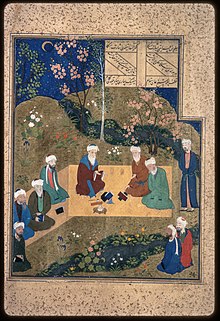Ali-Shir Nava'i
'Ali-Shir Nava'i (9 February 1441 – 3 January 1501), also known as Nizām-al-Din ʿAli-Shir Herawī (Chagatai: نظام الدین علی شیر نوایی, Persian: نظامالدین علیشیر نوایی) was a poet, writer, official, linguist, Hanafi Maturidi[1] mystic, and painter.[2] He was from the Timurid Empire.[3] He is thought to be one of the best Chagatai literature writers.[4][5]
Ali-Shir Nava'i | |
|---|---|
 16th-century portrait of Ali-Shir Nava'i by Mahmud Muzahhib, now located in the Museum of the Astan Quds Razavi in Mashhad, Iran | |
| Born | 9 February 1441 Herat, Timurid Empire |
| Died | 3 January 1501 (aged 59) Herat, Timurid Empire |
| Resting place | Herat, Afghanistan |
| Pen name | Navā'ī (or Nevā'ī) and Fāni |
| Occupation | Poet, writer, politician, linguist, mystic and painter |

Nava'i thought that his native Chagatai Turkic[6] language was better than Persian. He defended his opinion in his work called Muhakamat al-Lughatayn (The Comparison of the Two Languages).[7]
He made lots of Chagatai language poetry. Nava'i is thought to be the founder of early Turkic literature. Many places in Central Asia are named after him. In Uzbekistan, the province and city of Navoiy are named after him.
In Tashkent, Samarkand, Navoi, Seoul, Tokyo, Shanghai, Osh, Astana, Dushanbe, Herat, Baku, Moscow, Minsk, and Washington, D.C., there are statues and busts of him.
References
change- ↑ Nava'i, Ali-Shir (1996). Nasa'em al-mahabba men shama'em al-fotowwa. Turkish Language Association. p. 392.
- ↑ Subtelny 2011.
- ↑ Robinson, Chase; Foot, Sarah, eds. (2012). The Oxford History of Historical Writing Volume 2: 400-1400. Oxford University Press. p. 275. ISBN 978-0-191-63693-6.
... biographies on individuals only started to appear in larger numbers during the late fifteenth century under the Timurid dynasty, such as Khvandamir's glorification of his patron, the Timurid poet and statesman Mir Ali Shir Navai
- ↑ Robert McHenry, ed. (1993). "Navā'ī, (Mir) 'Alī Shīr". Encyclopædia Britannica. Vol. 8 (15th ed.). Chicago: Encyclopædia Britannica, Inc. p. 563.
- ↑ Subtelny 1993, p. 90-93.
- ↑ Dabashi, Hamid (2012). The World of Persian Literary Humanism. Harvard University Press. p. 165. ISBN 978-0-674-06759-2.
... in his (Nava'i's) own poetic and literary capabilities and wrote both in his native Chagatai Turkish and also in Persian, ...
- ↑ Валихўжаев, Ботирхон (13 November 2018). "«Муҳокамат ул-луғатайн» ҳақида". Xurshid Davron kutubxonasi (in Uzbek). Retrieved 20 October 2023.
Sources
change- Subtelny, Maria Eva (1993). "Mīr 'Alī Shīr Nawā'ī". In C. E. Bosworth; E. Van Donzel; W. P. Heinrichs; Ch. Pellat (eds.). The Encyclopedia of Islam. Vol. VII. Leiden—New York: E. J. Brill.
- Subtelny, Maria Eva (2011). "ʿAlī Shīr Navāʾī". In Fleet, Kate; Krämer, Gudrun; Matringe, Denis; Nawas, John; Rowson, Everett (eds.). Encyclopaedia of Islam, THREE. Brill Online. ISSN 1873-9830.
- Valitova, A. A. (1974). "Alisher Navoi". In A. M. Prokhorov (ed.). Great Soviet Encyclopedia. Vol. XVII. Moscow: Soviet Encyclopedia.
- Khwandamir (1979), Gandjei, T. (ed.), Makarim al-akhlak, Leiden
{{citation}}: CS1 maint: location missing publisher (link). - Babur (1905), Beveridge, A. S. (ed.), The Baburnama, Tashkent
{{citation}}: CS1 maint: location missing publisher (link). - Semenov, A. A. (1940), Materiali k bibliograficheskomy ukazatelyu pechatnykh proizvedeniy Alishera Navoi i literatury o nem. (Materials for a Bibliography of the Published Works of Alī Shīr Navā'ī and the Secondary Literature on Him), Tashkent
{{citation}}: CS1 maint: location missing publisher (link). - Levend, Agâh Sırri (1965–1968), Ali Şîr Nevaî, Ankara
{{citation}}: CS1 maint: location missing publisher (link). - Aybek, M. T., ed. (1948), Velikiy uzbekskiy poet. Sbornik statey (The Great Uzbek Poet), Tashkent
{{citation}}: CS1 maint: location missing publisher (link). - Erkinov, A. (1998), "The Perception of Works by Classical Authors in the 18th and 19th centuries Central Asia: The Example of the Xamsa of Ali Shir Nawa`i", in Kemper, Michael; Frank, Allen (eds.), Muslim Culture in Russia and Central Asia from the 18th to the Early 20th Centuries, vol. 2, Berlin, pp. 513–526
{{citation}}: CS1 maint: location missing publisher (link). - Nemati Limai, Amir (2015), Analysis of the Political Life of Amir Alishir Navai and Exploring His Cultural, Scientific, Social and Economic Works, Tehran & Mashhad: MFA (Cire)& Ferdowsi University.